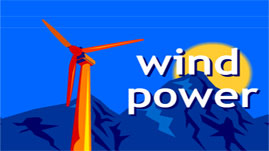Teachers' Domain - Digital Media for the Classroom and Professional Development
User: Preview

Source: U.S. Department of Energy
This animation presents the characteristics of wind power as a source of clean energy. The force of moving air generates electricity, by rotating blades around a rotor. The motion of the rotor turns a driveshaft that drives an electric generator.
The viewer may examine how a wind turbine works by pausing and clicking on its components. They include a gear box, rotor, high-speed shaft, generator, wind vane, yaw drive, yaw motor, anemometer, controller, tower, and brake.
Wind power is a feasible source of electricity in a variety of settings, and wind farms can operate on or off the electrical grid.
A wind turbine works the opposite of a fan. Instead of using electricity to make wind, like a fan, wind turbines use wind to make electricity. The wind turns the blades, which spin a shaft, which connects to a generator and makes electricity. The electrical power is sent through transmission lines to a substation and then on to customers who need it.
The uneven solar heating of the earth generates wind. The faster the speed of the wind, the more energy we can capture. For ages humans have captured the power of the wind using windmills to turn shafts and sails to propel boats. Wind turbines are modern versions of these older technologies. This animation from the U.S. Department of Energy explains the how each part of a commercial wind turbine works to turn kinetic energy into electricity.
The size of the turbine and the velocity of the wind are strong factors in how much energy a wind turbine can produce. Turbines like the one in the animation are often grouped into wind farms that produce large amounts of electricity. As more and more wind farms have sprung up, wind energy production has increased rapidly, growing 26.6% worldwide and 45% in the United States in 2007.1
One of the best ways to understand how a wind turbine works is to build one. The Kid Wind website (www.kidwind.org) is a comprehensive resource for getting kids excited about wind energy and helping educators to think and work through the details of experimenting with table-top wind turbines in the classroom.
To learn more about efforts in Pennsylvania to produce electricity using wind power, check out Pennsylvania Energy: Wind.
To see how solar and wind power are converted into electricity on a small scale, watch Dr. Andrew Lau's explanation Center for Sustainability at Penn State University: Energy System.
In this interactive Bear Creek Wind Farm Tour, a construction project manager explains the process of constructing a wind farm, its challenges and benefits.
1Kid Wind Project. “Wind Power Basics.” http://www.kidwind.org/lessons/BBwindpowerbasics.html, accessed 18 August 2008.
 Loading Standards
Loading Standards